The posts in this weblog are mainly about history, heritage, language, art, and culture of Persia (that is named Iran since 1934). Persia is, therefore, equal to Iran, and Persian is equal to Iranian. Note that Persian is a nationality not an ethnicity. Pars (or Fars) is the major ethnicity in Persia but there are also Persian Kurds or Arabs. Similarly, the official language in Persia is Persian (Farsi is the local name and may not be used internationally). For more details please read my posts.
Friday, August 25, 2006
The second Persian Empire (2): Sassanid
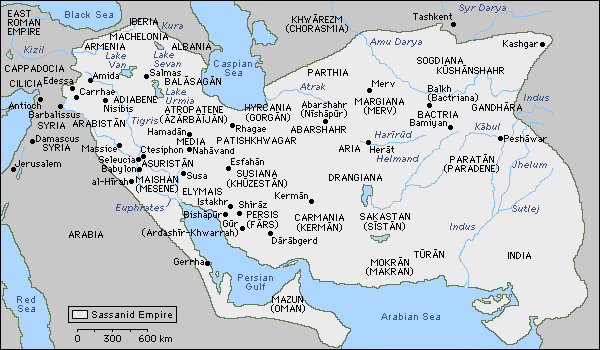 I hope you still remember the story of the Parthian Persian Empire that I told you. Here is the rest of the second Persian Empire: the Sassanids, as I promised.
I hope you still remember the story of the Parthian Persian Empire that I told you. Here is the rest of the second Persian Empire: the Sassanids, as I promised.
In the year 226, "Ardashir I" brought 500 year-old Parthian Empire to an end and began four centuries of Sassanid rule (until the year 651). This incredible achievement of Ardeshir I is carved in stone in Naqsh-e Rostam (near Persepolis, the famous capital of the first Persian Empire) . There you can see Ahuramazda, the supreme god, handing over the ring of power to Ardashir I. The religion of Persians was Zoroastrianism at that time (before the invasion of Arabs that introduced Islam to Persia). In fact, the lasting heritage of the Sassanid Persian Empire is the Avesta, the holy book of the prophet Zarathustra.
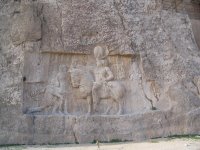 Second Persian Empire coexisted with Roman Empire, and there were great battles between them. Many of the victories of Persians is carved in stone. An example is the triumph relief of Shapur I (241-272), the most famous Sassanid rock relief. It is also located in Naqsh-e Rostam, very close to the tomb of Darius I the Great. It shows how he has defeated two Roman emperors: Emperor Valerian and Philippus Arabs. You can also find Sassanid reliefs in many other places of Persia, such as Bishapur, Taq-e Bostan, Naqsh-e Rajab, and Firuzabad. An amazing characteristic of those reliefs is that they are individualistic: the kings can be identified by their crowns. For more detailed information, please look at the LIVUS website, the page about Sassanid rock reliefs.
Second Persian Empire coexisted with Roman Empire, and there were great battles between them. Many of the victories of Persians is carved in stone. An example is the triumph relief of Shapur I (241-272), the most famous Sassanid rock relief. It is also located in Naqsh-e Rostam, very close to the tomb of Darius I the Great. It shows how he has defeated two Roman emperors: Emperor Valerian and Philippus Arabs. You can also find Sassanid reliefs in many other places of Persia, such as Bishapur, Taq-e Bostan, Naqsh-e Rajab, and Firuzabad. An amazing characteristic of those reliefs is that they are individualistic: the kings can be identified by their crowns. For more detailed information, please look at the LIVUS website, the page about Sassanid rock reliefs.
I should not forget to say something about Bisotun. It's a city in the west side of Persia, which contains very interesting features from all the Persian Empires. This year (2006), Bisotun is inscribed in the list of UNESCO World Heritage.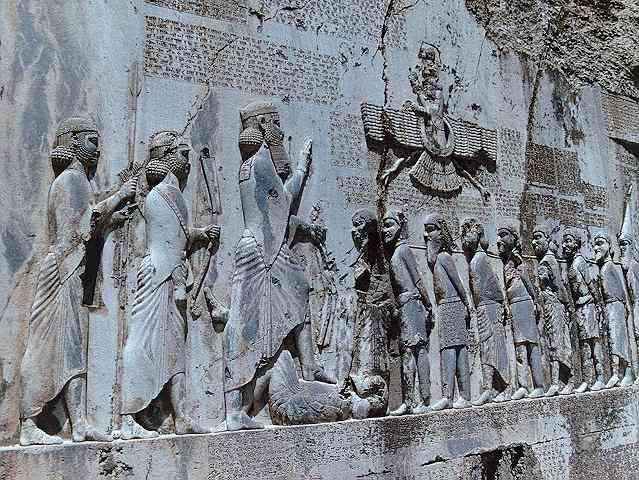 The most famous feature is the Bisotun Inscription, related to Darius the Great (the second king of the first Persian Empire). It is engraved on a cliff about 100 meters off the ground, and below and around it there are ca. 1,200 lines of inscriptions. It tells the story of the battles Darius waged in 521-520 BC against the governors who attempted to take apart the Empire founded by Cyrus (the first king). The inscription is written in three languages: the oldest is an Elamite text, followed by a Babylonian version and an Old Persian version of similar legends. This document is most crucial in the decipherment of a previously lost script. To Old Persian language, it is what the Rosetta Stone is to Egyptian hieroglyphs.
The most famous feature is the Bisotun Inscription, related to Darius the Great (the second king of the first Persian Empire). It is engraved on a cliff about 100 meters off the ground, and below and around it there are ca. 1,200 lines of inscriptions. It tells the story of the battles Darius waged in 521-520 BC against the governors who attempted to take apart the Empire founded by Cyrus (the first king). The inscription is written in three languages: the oldest is an Elamite text, followed by a Babylonian version and an Old Persian version of similar legends. This document is most crucial in the decipherment of a previously lost script. To Old Persian language, it is what the Rosetta Stone is to Egyptian hieroglyphs.
Bisotun was also an important place during the second Persian Empire. There are several rock reliefs there from both the Parthian and the Sassanids. It is no coincidence that the scene of the sad story about the star-crossed lovers Shirin and Farhad and Shirin's husband, the Sassanid king Khusrau II (590-628), is laid at Bisotun.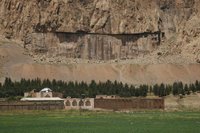 Khusrau II is also connected to the last known monument at Bisotun: The unfinished relief. His armies had captured Syria, Jerusalem in 614, Egypt and even reached Constantinople. It seemed as if the Achaemenid empire was restored, and Khusrau ordered the making of brilliant rock reliefs at Taq-e Bostan and Behistun. The monument at Taq-e Bostan was finished, but the Behistun relief was not: all that is visible is a piece of rock that was cleared.
Khusrau II is also connected to the last known monument at Bisotun: The unfinished relief. His armies had captured Syria, Jerusalem in 614, Egypt and even reached Constantinople. It seemed as if the Achaemenid empire was restored, and Khusrau ordered the making of brilliant rock reliefs at Taq-e Bostan and Behistun. The monument at Taq-e Bostan was finished, but the Behistun relief was not: all that is visible is a piece of rock that was cleared.
The capital city of the second Persian Empire was Ctesiphon (also known as "Tisfun", or in arabic "Madain"). The legendary architecture of that city, the Great Arch (Ayvan-e Madain, Taq-e Khusrau, Taq-e Kasra), still exists but is in danger. It is not yet registered in the UNESCO World Heritage. The arch is located in what is now the Iraqi town of Salman Pak (formerly, Madain), just to the south of the capital, Baghdad. I hope in near future the new government of Iraq do some effort to restore this extraordinary structure.
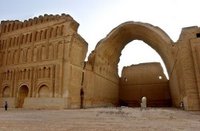
The last king of the second Persian Empire was Yazdgard III, whose reign began in 632. In 636, the Arabs took Ctesiphon, in 641, they invaded Persia (battle of Nehavand), and ten years later, the last Sassanid king died as a fugitive.
 I hope you still remember the story of the Parthian Persian Empire that I told you. Here is the rest of the second Persian Empire: the Sassanids, as I promised.
I hope you still remember the story of the Parthian Persian Empire that I told you. Here is the rest of the second Persian Empire: the Sassanids, as I promised.In the year 226, "Ardashir I" brought 500 year-old Parthian Empire to an end and began four centuries of Sassanid rule (until the year 651). This incredible achievement of Ardeshir I is carved in stone in Naqsh-e Rostam (near Persepolis, the famous capital of the first Persian Empire) . There you can see Ahuramazda, the supreme god, handing over the ring of power to Ardashir I. The religion of Persians was Zoroastrianism at that time (before the invasion of Arabs that introduced Islam to Persia). In fact, the lasting heritage of the Sassanid Persian Empire is the Avesta, the holy book of the prophet Zarathustra.
 Second Persian Empire coexisted with Roman Empire, and there were great battles between them. Many of the victories of Persians is carved in stone. An example is the triumph relief of Shapur I (241-272), the most famous Sassanid rock relief. It is also located in Naqsh-e Rostam, very close to the tomb of Darius I the Great. It shows how he has defeated two Roman emperors: Emperor Valerian and Philippus Arabs. You can also find Sassanid reliefs in many other places of Persia, such as Bishapur, Taq-e Bostan, Naqsh-e Rajab, and Firuzabad. An amazing characteristic of those reliefs is that they are individualistic: the kings can be identified by their crowns. For more detailed information, please look at the LIVUS website, the page about Sassanid rock reliefs.
Second Persian Empire coexisted with Roman Empire, and there were great battles between them. Many of the victories of Persians is carved in stone. An example is the triumph relief of Shapur I (241-272), the most famous Sassanid rock relief. It is also located in Naqsh-e Rostam, very close to the tomb of Darius I the Great. It shows how he has defeated two Roman emperors: Emperor Valerian and Philippus Arabs. You can also find Sassanid reliefs in many other places of Persia, such as Bishapur, Taq-e Bostan, Naqsh-e Rajab, and Firuzabad. An amazing characteristic of those reliefs is that they are individualistic: the kings can be identified by their crowns. For more detailed information, please look at the LIVUS website, the page about Sassanid rock reliefs.I should not forget to say something about Bisotun. It's a city in the west side of Persia, which contains very interesting features from all the Persian Empires. This year (2006), Bisotun is inscribed in the list of UNESCO World Heritage.
 The most famous feature is the Bisotun Inscription, related to Darius the Great (the second king of the first Persian Empire). It is engraved on a cliff about 100 meters off the ground, and below and around it there are ca. 1,200 lines of inscriptions. It tells the story of the battles Darius waged in 521-520 BC against the governors who attempted to take apart the Empire founded by Cyrus (the first king). The inscription is written in three languages: the oldest is an Elamite text, followed by a Babylonian version and an Old Persian version of similar legends. This document is most crucial in the decipherment of a previously lost script. To Old Persian language, it is what the Rosetta Stone is to Egyptian hieroglyphs.
The most famous feature is the Bisotun Inscription, related to Darius the Great (the second king of the first Persian Empire). It is engraved on a cliff about 100 meters off the ground, and below and around it there are ca. 1,200 lines of inscriptions. It tells the story of the battles Darius waged in 521-520 BC against the governors who attempted to take apart the Empire founded by Cyrus (the first king). The inscription is written in three languages: the oldest is an Elamite text, followed by a Babylonian version and an Old Persian version of similar legends. This document is most crucial in the decipherment of a previously lost script. To Old Persian language, it is what the Rosetta Stone is to Egyptian hieroglyphs.Bisotun was also an important place during the second Persian Empire. There are several rock reliefs there from both the Parthian and the Sassanids. It is no coincidence that the scene of the sad story about the star-crossed lovers Shirin and Farhad and Shirin's husband, the Sassanid king Khusrau II (590-628), is laid at Bisotun.
 Khusrau II is also connected to the last known monument at Bisotun: The unfinished relief. His armies had captured Syria, Jerusalem in 614, Egypt and even reached Constantinople. It seemed as if the Achaemenid empire was restored, and Khusrau ordered the making of brilliant rock reliefs at Taq-e Bostan and Behistun. The monument at Taq-e Bostan was finished, but the Behistun relief was not: all that is visible is a piece of rock that was cleared.
Khusrau II is also connected to the last known monument at Bisotun: The unfinished relief. His armies had captured Syria, Jerusalem in 614, Egypt and even reached Constantinople. It seemed as if the Achaemenid empire was restored, and Khusrau ordered the making of brilliant rock reliefs at Taq-e Bostan and Behistun. The monument at Taq-e Bostan was finished, but the Behistun relief was not: all that is visible is a piece of rock that was cleared.The capital city of the second Persian Empire was Ctesiphon (also known as "Tisfun", or in arabic "Madain"). The legendary architecture of that city, the Great Arch (Ayvan-e Madain, Taq-e Khusrau, Taq-e Kasra), still exists but is in danger. It is not yet registered in the UNESCO World Heritage. The arch is located in what is now the Iraqi town of Salman Pak (formerly, Madain), just to the south of the capital, Baghdad. I hope in near future the new government of Iraq do some effort to restore this extraordinary structure.

The last king of the second Persian Empire was Yazdgard III, whose reign began in 632. In 636, the Arabs took Ctesiphon, in 641, they invaded Persia (battle of Nehavand), and ten years later, the last Sassanid king died as a fugitive.
Labels: Art, Persian heritage, Persian history
Comments:
<< Home
i thought persian was an ethnicity and iranian was the nationality..
what if your ehtnic persian like bakhtiari or lor or something
what if your ehtnic persian like bakhtiari or lor or something
Thank you 'my blog on stuff' for your comment. A "Persian," who is a person with the nationality of Persia, can be of course Lor, Arab, Bakhtiari, Pars, Tork, Kord, etc.
It means that in the same way that we have Iraqi Kord and Iraqi Arabs, we have also Persian Kord, Persian Arab, Persian Pars, Persian Lor, etc.
Post a Comment
It means that in the same way that we have Iraqi Kord and Iraqi Arabs, we have also Persian Kord, Persian Arab, Persian Pars, Persian Lor, etc.
Subscribe to Post Comments [Atom]
<< Home



